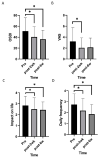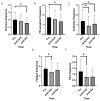Effect of Oral Choline Alfoscerate on Patients with Keratoconjunctivitis Sicca
- PMID: 32456260
- PMCID: PMC7284981
- DOI: 10.3390/nu12051526
Effect of Oral Choline Alfoscerate on Patients with Keratoconjunctivitis Sicca
Abstract
Keratoconjunctivitis sicca (KCS) or dry eye is a disease characterized by ocular surface symptoms. This study aimed to investigate the effectiveness of oral choline alfoscerate (CA) administration as a treatment for KCS. The medical records of dry eye patients who were refractory to topical eyedrops and then took oral CA were reviewed. Results of tear break-up time (TBUT), fluorescein ocular surface staining score (FSS), and tear secretion by the Schirmer test (STT) were analyzed. The results of the ocular surface disease index (OSDI), visual analog pain score (VAS), reporting of the severity and frequency of symptoms, and the modified Standardized Patient Evaluation of Eye Dryness (SPEED) questionnaire were also analyzed. The records of 47 patients were analyzed for this study. The mean age was 62.8 ± 9.3 years, and the patients included 9 males and 38 females. TBUT, OSDI, and VAS significantly improved after CA administration compared to before (p < 0.05, paired t-test). After CA administration, symptom frequency and impact on life improved (p < 0.05, paired t-test). No significant change in photophobia or FSS was identified. In conclusion, oral CA administration was effective in improving tear stability and alleviating symptoms of KCS.
Keywords: choline alfoscerate; dry eye symptoms; keratoconjunctivitis sicca; tear break-up time.
Conflict of interest statement
The authors declare no conflict of interest.
Figures




References
MeSH terms
Substances
Grants and funding
LinkOut - more resources
Full Text Sources

